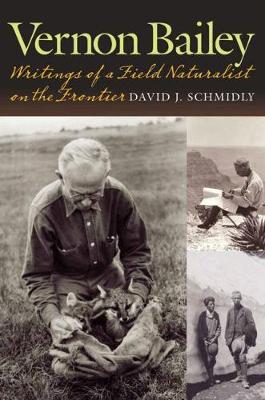Integrative Natural History
1 total work
For the first time, this volume presents Vernon Bailey's correspondences and field notes spanning the majority of his life and career, collected and annotated by David J. Schmidly. Born in 1864 and raised on a Minnesota farm, Vernon Bailey became the first person to conduct extensive biological surveys of Texas, New Mexico, North Dakota, and Oregon. He was one of the founding members of the American Society of Mammalogists and pioneered the humane treatment of animals during fieldwork, developing and patenting traps designed to limit injuries or unnecessary stress.
From an early age, Bailey developed an affinity for animals, observing their behaviors and eventually collecting specimens for closer study. He developed his own traps for catching mammals, birds, and reptiles and taught himself taxidermy from a book. When he was twenty-one, Bailey began sending samples of the animals he preserved to C. H. Merriam, the chief of the newly created Division of Economic Ornithology and Mammalogy of the USDA, later renamed the Bureau of Biological Survey and now the US Fish and Wildlife Service. Merriam was so impressed with Baily's work that he hired him, appointed him special field agent, and promptly sent him to the “inner frontiers” of the western and southwestern United States, despite the fact that Bailey had no formal training in biology.
During his long career, Bailey kept detailed field notes, chronicling his travels and wildlife observations. These writings provide fascinating insight into not only people's relationships with and efforts to understand wildlife but also the ways the country was rapidly growing and changing at the beginning of the twentieth century.
From an early age, Bailey developed an affinity for animals, observing their behaviors and eventually collecting specimens for closer study. He developed his own traps for catching mammals, birds, and reptiles and taught himself taxidermy from a book. When he was twenty-one, Bailey began sending samples of the animals he preserved to C. H. Merriam, the chief of the newly created Division of Economic Ornithology and Mammalogy of the USDA, later renamed the Bureau of Biological Survey and now the US Fish and Wildlife Service. Merriam was so impressed with Baily's work that he hired him, appointed him special field agent, and promptly sent him to the “inner frontiers” of the western and southwestern United States, despite the fact that Bailey had no formal training in biology.
During his long career, Bailey kept detailed field notes, chronicling his travels and wildlife observations. These writings provide fascinating insight into not only people's relationships with and efforts to understand wildlife but also the ways the country was rapidly growing and changing at the beginning of the twentieth century.
